Corrosion Behavior and Morphology of Passive Films Modified with Zinc–Aluminum Simultaneous Treatment on Different Metals
Abstract
1. Introduction
2. Materials and Methods
2.1. Samples Preparation
2.2. Solutions Preparation
2.3. High Temperature Treatment
2.4. Electrochemical Measurements
2.5. Morphology and Composition Analysis
3. Results
3.1. Potentiodynamic Polarization
3.2. EIS
3.3. Mott–Schottky Curve
3.4. Morphology and Composition Analysis
3.4.1. A508-3
3.4.2. 304L
3.4.3. In800
4. Discussion
5. Conclusions
Author Contributions
Funding
Conflicts of Interest
References
- Lee, T.H.; Ryu, K.H.; Kim, H.D.; Hwang, I.S.; Kim, J.H.; Lee, M.H.; Choi, S. Effect of oxide film on ECT detectability of surface IGSCC in laboratory-degraded alloy 600 steam generator tubing. Nucl. Eng. Technol. 2019, 51, 1381–1389. [Google Scholar] [CrossRef]
- Lin, X.; Peng, Q.; Mei, J.; Han, E.-H.; Ke, W.; Qiao, L.; Jiao, Z. Corrosion of phase and phase boundary in proton-irradiated 308L stainless steel weld metal in simulated PWR primary water. Corros. Sci. 2020, 165, 108401. [Google Scholar] [CrossRef]
- Ru, X.; Ma, J.; Lu, Z.; Chen, J.; Han, G.; Zhang, J.; Hu, P.; Liang, X.; Tang, W. Effects of iron content in NiCrFe alloys on the oxide films formed in an oxygenated simulated PWR water environment. J. Nucl. Mater. 2018, 509, 29–42. [Google Scholar] [CrossRef]
- Tan, Y.; Yang, J.; Wang, W.; Shi, R.; Liang, K.; Zhang, S. Effects of PbO on the oxide films of incoloy 800HT in simulated primary circuit of PWR. J. Nucl. Mater. 2016, 473, 119–124. [Google Scholar] [CrossRef]
- Mohammed, G.R.; Ishak, M.; Aqida, S.N.; Abdulhadi, H.A. Effects of Heat Input on Microstructure, Corrosion and Mechanical Characteristics of Welded Austenitic and Duplex Stainless Steels: A Review. Metals 2017, 7, 39. [Google Scholar] [CrossRef]
- Zhang, S.; Shi, R.; Tan, Y. Corrosion behavior of the oxide films modified with zincizing treatment on AISI 1020 steel. J. Alloy. Compd. 2017, 711, 155–161. [Google Scholar] [CrossRef]
- Kawamura, H.; Hirano, H.; Katsumura, Y.; Uchida, S.; Mizuno, T.; Kitajima, H.; Tsuzuki, Y.; Terachi, T.; Nagase, M.; Usui, N.; et al. BWR water chemistry guidelines and PWR primary water chemistry guidelines in Japan—Purpose and technical background. Nucl. Eng. Des. 2016, 309, 161–174. [Google Scholar] [CrossRef]
- Sawicki, J.A. Analyses of fuel crud and coolant-borne corrosion products in normal water chemistry BWRs. J. Nucl. Mater. 2011, 419, 85–96. [Google Scholar] [CrossRef]
- Ziemniak, S.E.; Hanson, M. Zinc treatment effects on corrosion behavior of Alloy 600 in high temperature, hydrogenated water. Corros. Sci. 2006, 48, 3330–3348. [Google Scholar] [CrossRef]
- Arjmand, F.; Wang, J.; Zhang, L. Zinc addition and its effect on the corrosion behavior of a 30% cold forged Alloy 690 in simulated primary coolant of pressurized water reactors. J. Alloy. Compd. 2019, 791, 1176–1192. [Google Scholar] [CrossRef]
- Hanzawa, Y.; Hiroishi, D.; Matsuura, C.; Ishigure, K. Solubility of zinc ferrite in high-temperature oxygenated water. J. Nucl. Mater. 1998, 252, 209–215. [Google Scholar] [CrossRef]
- Zhang, S.; Tan, Y.; Liang, K. Zinc addition changes the semiconductor properties of oxide films of Alloy600 in high temperature water. Mater. Lett. 2012, 68, 36–39. [Google Scholar] [CrossRef]
- Liu, X.; Wu, X.; Han, E.-H. Electrochemical and surface analytical investigation of the effects of Zn concentrations on characteristics of oxide films on 304 stainless steel in borated and lithiated high temperature water. Electrochim. Acta 2013, 108, 554–565. [Google Scholar] [CrossRef]
- Liu, X.; Wu, X.; Han, E.-H. Influence of Zn injection on characteristics of oxide film on 304 stainless steel in borated and lithiated high temperature water. Corros. Sci. 2011, 53, 3337–3345. [Google Scholar] [CrossRef]
- Betova, I.; Bojinov, M.; Kinnunen, P.; Lundgren, K.; Saario, T. Influence of Zn on the oxide layer on AISI 316L(NG) stainless steel in simulated pressurised water reactor coolant. Electrochim. Acta 2009, 54, 1056–1069. [Google Scholar] [CrossRef]
- Borisevich, V.D.; Pavlov, A.V.; Okhotina, I.A. Depleted zinc: Properties, application, production. Appl. Radiat. Isot. 2009, 67, 1167–1172. [Google Scholar] [CrossRef] [PubMed]
- Kato, M.; Koiwai, M.; Kuwano, J. The aluminium ion as a corrosion inhibitor for iron in water. Corros. Sci. 1979, 19, 937–947. [Google Scholar] [CrossRef]
- Zhang, S.; Shi, R.; Chen, Y.; Wang, M. Corrosion behavior of oxide films on AISI 316L SS formed in high temperature water with simultaneous injection of zinc and aluminum. J. Alloy. Compd. 2018, 731, 1230–1237. [Google Scholar] [CrossRef]
- Kelm, H.; Glaubitz, U.; Hoffmann, W.; Schlenkrich, H.; Thieme, M. Corrosion product build-up on stainless steel and its influence on hydrazine decomposition.60Co deposition in loop tests using borated water at 300 °C. J. Solut. Chem. 1992, 21, 901–918. [Google Scholar] [CrossRef]
- Bandy, R. The simultaneous determination of tafel constants and corrosion rate—A new method. Corros. Sci. 1980, 20, 1017–1028. [Google Scholar] [CrossRef]
- Barnartt, S. Two-point and three-point methods for the investigation of electrode reaction mechanisms. Electrochim. Acta 1970, 15, 1313–1324. [Google Scholar] [CrossRef]
- McCafferty, E. Validation of corrosion rates measured by the Tafel extrapolation method. Corros. Sci. 2005, 47, 3202–3215. [Google Scholar] [CrossRef]
- Taylor, R.J.; Williams, L.F.G. Corrosion Rate Measurements on Steel in Sulfuric Acid Using a Microprocessor Controlled Potentiostat. Corrosion 1980, 36, 41–47. [Google Scholar] [CrossRef]
- Stellwag, B. The mechanism of oxide film formation on austenitic stainless steels in high temperature water. Corros. Sci. 1998, 40, 337–370. [Google Scholar] [CrossRef]
- Ziemniak, S.E.; Hanson, M. Zinc treatment effects on corrosion behavior of 304 stainless steel in high temperature, hydrogenated water. Corros. Sci. 2006, 48, 2525–2546. [Google Scholar] [CrossRef]
- Ziemniak, S.E.; Hanson, M. Corrosion behavior of 304 stainless steel in high temperature, hydrogenated water. Corros. Sci. 2002, 44, 2209–2230. [Google Scholar] [CrossRef]
- Ziemniak, S.E.; Hanson, M. Corrosion behavior of NiCrFe Alloy 600 in high temperature, hydrogenated water. Corros. Sci. 2006, 48, 498–521. [Google Scholar] [CrossRef]
- Alves, V.A.; Brett, C.M.A. Characterisation of passive films formed on mild steels in bicarbonate solution by EIS. Electrochim. Acta 2002, 47, 2081–2091. [Google Scholar] [CrossRef]
- Rodríguez, M.n.A.; Carranza, R.M. Properties of the Passive Film on Alloy 22 in Chloride Solutions Obtained by Electrochemical Impedance. J. Electrochem. Soc. 2011, 158, C221. [Google Scholar] [CrossRef]
- Martini, E.M.A.; Muller, I.L. Characterization of the film formed on iron in borate solution by electrochemical impedance spectroscopy. Corros. Sci. 2000, 42, 443–454. [Google Scholar] [CrossRef]
- Brug, G.J.; van den Eeden, A.L.G.; Sluyters-Rehbach, M.; Sluyters, J.H. The analysis of electrode impedances complicated by the presence of a constant phase element. J. Electroanal. Chem. Interfacial Electrochem. 1984, 176, 275–295. [Google Scholar] [CrossRef]
- Hirschorn, B.; Orazem, M.E.; Tribollet, B.; Vivier, V.; Frateur, I.; Musiani, M. Determination of effective capacitance and film thickness from constant-phase-element parameters. Electrochim. Acta 2010, 55, 6218–6227. [Google Scholar] [CrossRef]
- Harrington, S.; Devine, T. Relation Between the Semiconducting Properties of a Passive Film and Reduction Reaction Rates. J. Electrochem. Soc. 2009, 156, C154–C159. [Google Scholar] [CrossRef]
- Vetter, K. Electrochemical Kinetics: Theoretical and Experimental Aspects; Academic Press: New York, NY, USA, 1967. [Google Scholar]
- Gomes, W.P.; Vanmaekelbergh, D. Impedance spectroscopy at semiconductor electrodes: Review and recent developments. Electrochim. Acta 1996, 41, 967–973. [Google Scholar] [CrossRef]
- Tsuchiya, H.; Fujimoto, S.; Chihara, O.; Shibata, T. Semiconductive behavior of passive films formed on pure Cr and Fe–Cr alloys in sulfuric acid solution. Electrochim. Acta 2002, 47, 4357–4366. [Google Scholar] [CrossRef]
- Kim, Y.S.; Kim, J.G. Corrosion Behavior of Pipeline Carbon Steel under Different Iron Oxide Deposits in the District Heating System. Metals 2017, 7, 182. [Google Scholar] [CrossRef]
- Ahn, S.J.; Kwon, H.S. Effects of solution temperature on electronic properties of passive film formed on Fe in pH 8.5 borate buffer solution. Electrochim. Acta 2004, 49, 3347–3353. [Google Scholar] [CrossRef]
- Hamadou, L.; Kadri, A.; Benbrahim, N. Characterisation of passive films formed on low carbon steel in borate buffer solution (pH 9.2) by electrochemical impedance spectroscopy. Appl. Surf. Sci. 2005, 252, 1510–1519. [Google Scholar] [CrossRef]
- Feng, Z.; Cheng, X.; Dong, C.; Xu, L.; Li, X. Passivity of 316L stainless steel in borate buffer solution studied by Mott–Schottky analysis, atomic absorption spectrometry and X-ray photoelectron spectroscopy. Corros. Sci. 2010, 52, 3646–3653. [Google Scholar] [CrossRef]
- Levine, S.; Smith, A. Theory of the Differential Capacity of the Oxide/Aqueous Electrolyte Interface. Discuss. Faraday Soc. 1971, 52. [Google Scholar] [CrossRef]
- Kawamura, H.; Shirai, S.; Matsunaga, T.; Oshinden, K.; Takiguchi, H.; Yamaoka, K.; Takamatsu, H.; Hirano, H. Inhibitory Effect of Zinc Addition to High-Temperature Hydrogenated Water on Mill-Annealed and Prefilmed Alloy 600. Corrosion 2000, 56. [Google Scholar] [CrossRef]
- Kim, H.-S.; Lee, H.B.; Chen, J.; Jang, C.; Kim, T.S.; Stevens, G.L.; Ahluwalia, K. Effect of zinc on the environmentally-assisted fatigue behavior of 316 stainless steels in simulated PWR primary environment. Corros. Sci. 2019, 151, 97–107. [Google Scholar] [CrossRef]
- Han, M.; Wang, Z.; Xu, Y.; Wu, R.; Jiao, S.; Chen, Y.; Feng, S. Physical properties of MgAl2O4, CoAl2O4, NiAl2O4, CuAl2O4, and ZnAl2O4 spinels synthesized by a solution combustion method. Mater. Chem. Phys. 2018, 215, 251–258. [Google Scholar] [CrossRef]
- Inoue, M.; Otsu, H.; Kominami, H.; Inui, T. ChemInform Abstract: Synthesis of Double Oxides Having Spinel Structure (ZnAl2O4, ZnGa2O4) by the Glycothermal Method. ChemInform 1991, 22. [Google Scholar] [CrossRef]
- Stringhini, F.M.; Foletto, E.L.; Sallet, D.; Bertuol, D.A.; Chiavone-Filho, O.; Nascimento, C.A. Synthesis of porous zinc aluminate spinel (ZnAl2O4) by metal-chitosan complexation method. J. Alloy. Compd. 2014, 588, 305–309. [Google Scholar] [CrossRef]
- Cao, L.; Wang, G.C.; Yuan, X.H.; Jin, P.L.; Sridhar, S. Thermodynamics and Agglomeration Behavior on Spinel Inclusion in Al-Deoxidized Steel Coupling with Mg Treatment. Metals 2019, 9, 900. [Google Scholar] [CrossRef]
- Levy, D.; Pavese, A.; Sani, A.; Pischedda, V. Structure and compressibility of synthetic ZnAl2O4 (gahnite) under high-pressure conditions, from synchrotron X-ray powder diffraction. Phys. Chem. Miner. 2001, 28, 612–618. [Google Scholar] [CrossRef]
- Gorla, C.; Mayo, W.; Liang, S.; Lu, Y. Structure and Interface-Controlled Growth Kinetics of ZnAl2O4 Formed at the (1120) ZnO/(0112) Al2O3 Interface. J. Appl. Phys. 2000, 87, 3736–3743. [Google Scholar] [CrossRef]
- Khenata, R.; Sahnoun, M.; Baltache, H.; Rérat, M.; Reshak, A.H.; Al-Douri, Y.; Bouhafs, B. Full-potential calculations of structural, elastic and electronic properties of MgAl2O4 and ZnAl2O4 compounds. Phys. Lett. A 2005, 344, 271–279. [Google Scholar] [CrossRef]
- Liu, L.; Chen, M.; Xu, L.; Yin, X.L.; Sun, W.J. Effect of BaO Addition on Densification and Mechanical Properties of Al2O3-MgO-CaO Refractories. Metals 2016, 6, 84. [Google Scholar] [CrossRef]
- Davey, W.P. An Introduction to Crystal Chemistry (Evans, R.C.). J. Chem. Educ. 1940, 17, 451. [Google Scholar] [CrossRef]
- Kamada, K.; Shoji, Y.; Yamaji, A.; Kurosawa, S.; Yokota, Y.; Ohashi, Y.; Kim, K.J.; Ivanov, M.; Kochurikhin, V.V.; Yoshikawa, A. Melt growth of zinc aluminate spinel single crystal by the micro-pulling down method under atmospheric pressure. J. Cryst. Growth 2018, 492, 67–70. [Google Scholar] [CrossRef]
- D’Ippolito, V.; Andreozzi, G.; Bosi, F.; Hålenius, U.; Mantovani, L.; Bersani, D.; Fregola, R. Crystallographic and spectroscopic characterization of a natural Zn-rich spinel approaching the endmember gahnite (ZnAl2O4) composition. Mineral. Mag. 2013, 77, 2941–2953. [Google Scholar] [CrossRef]



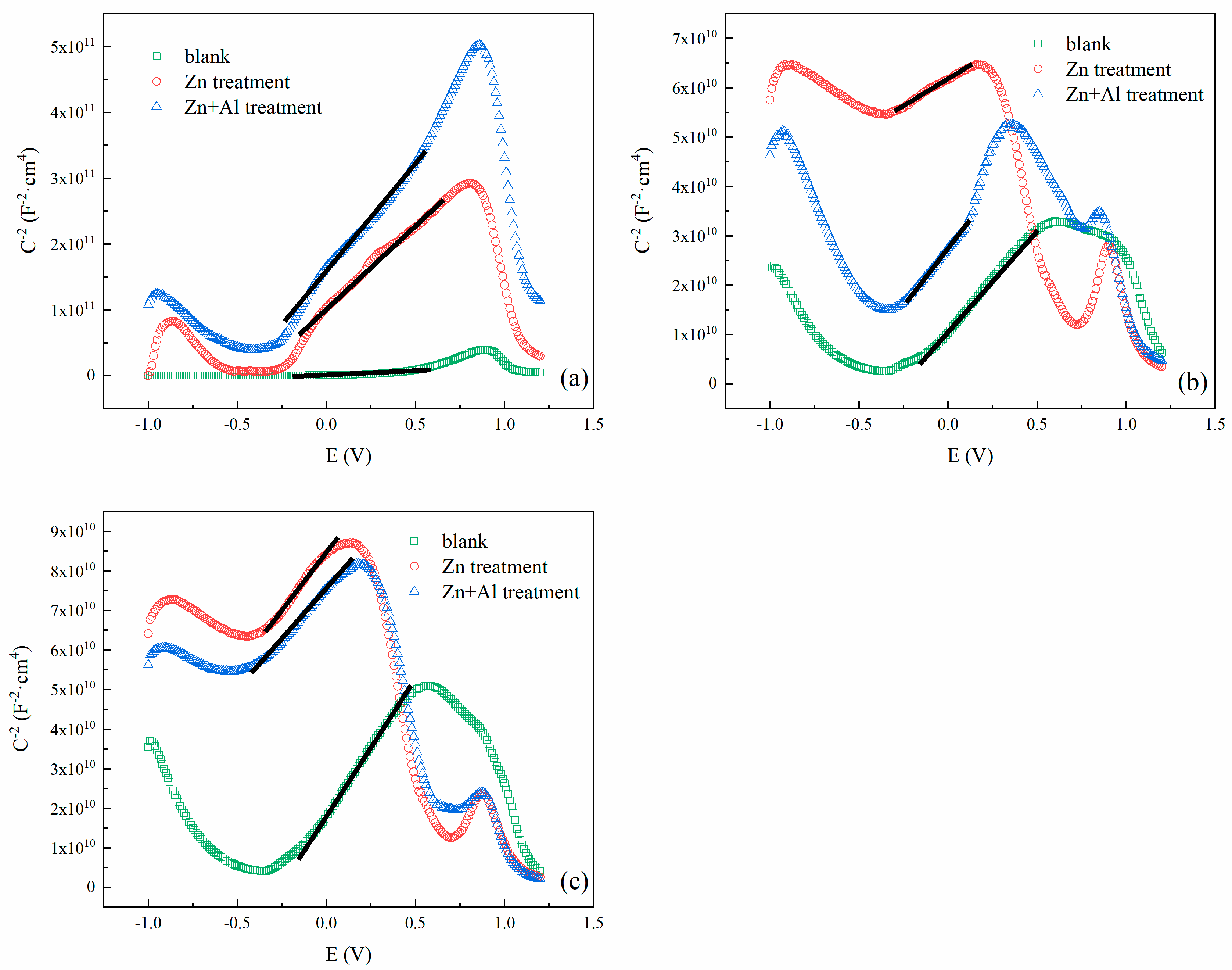

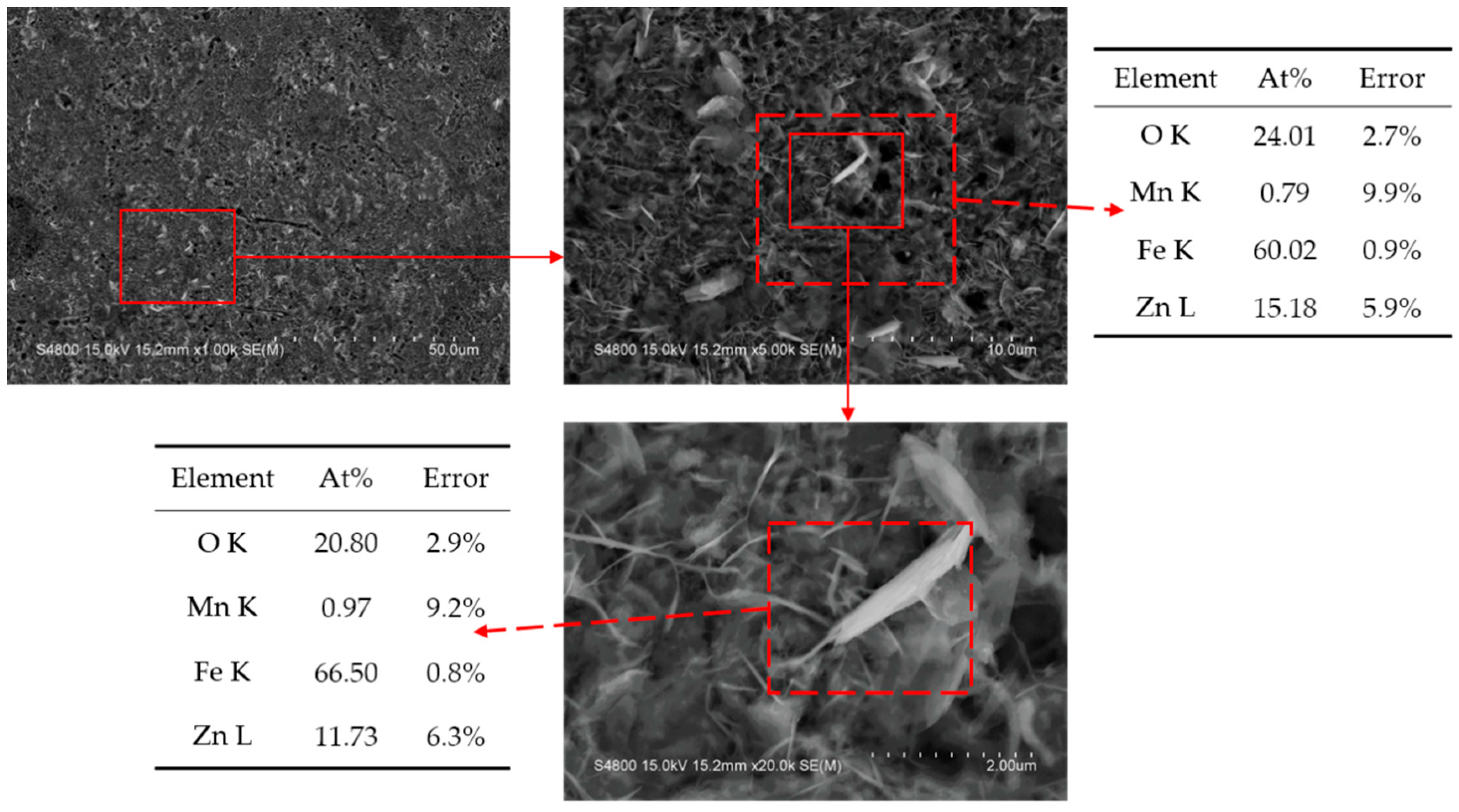
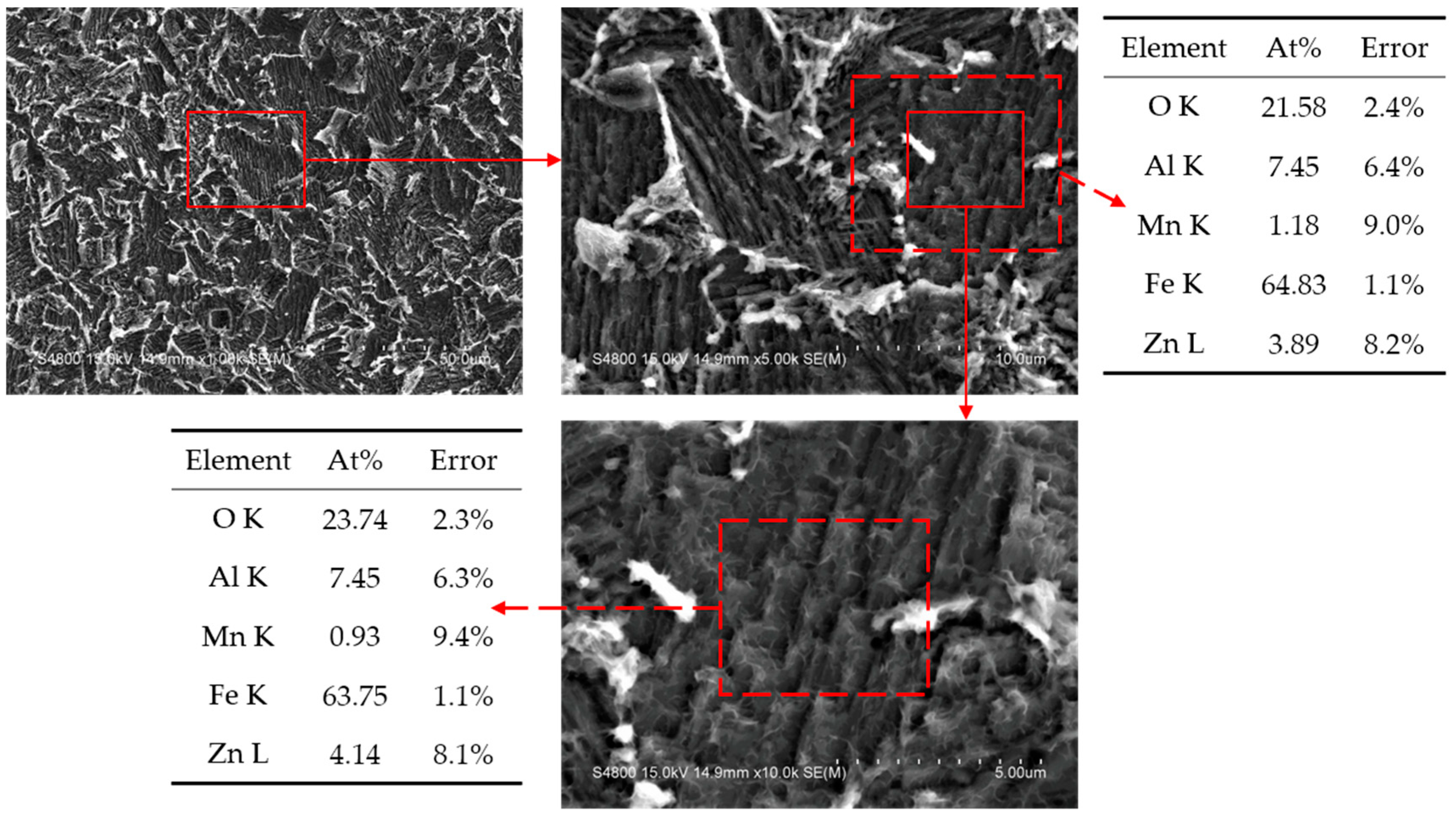
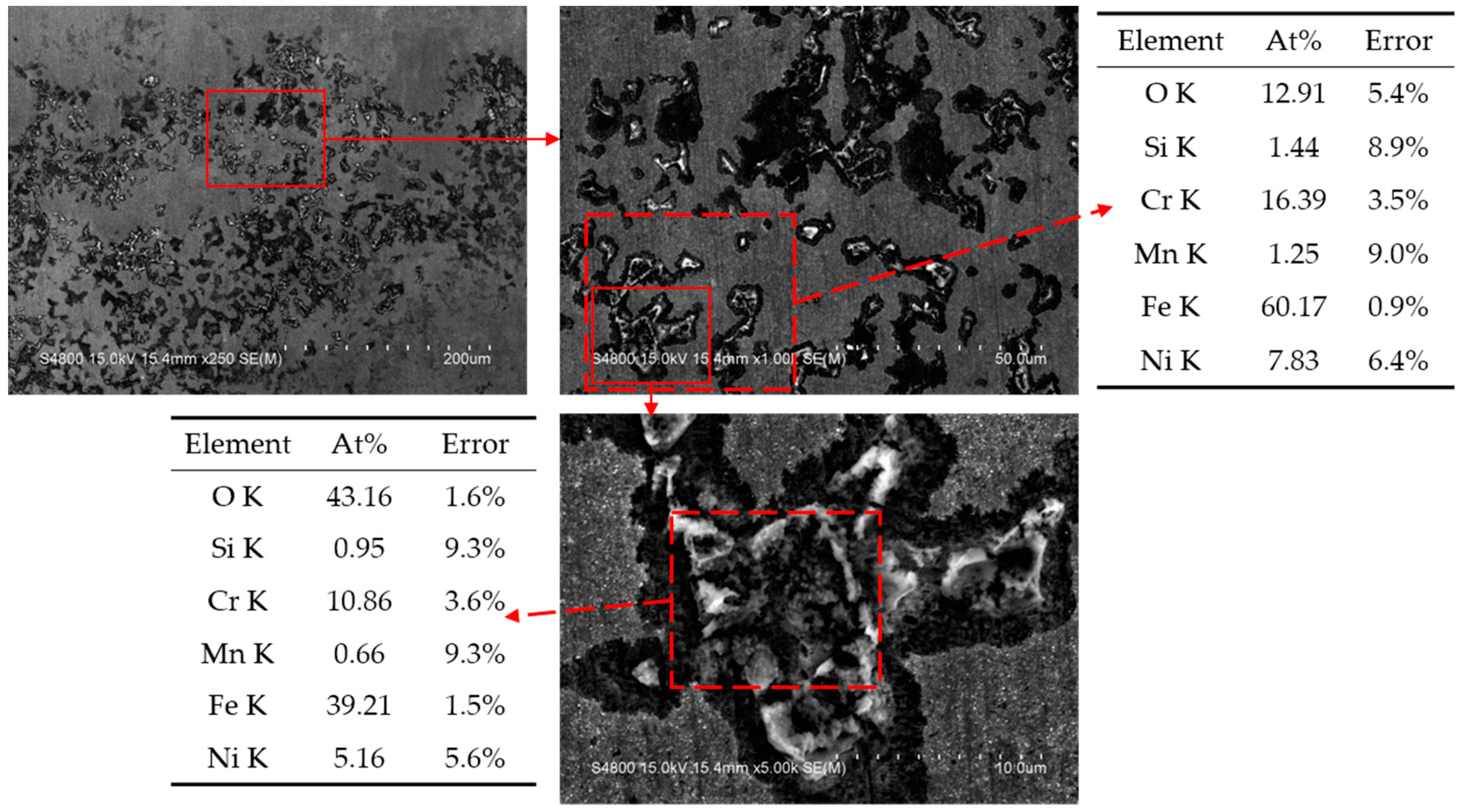
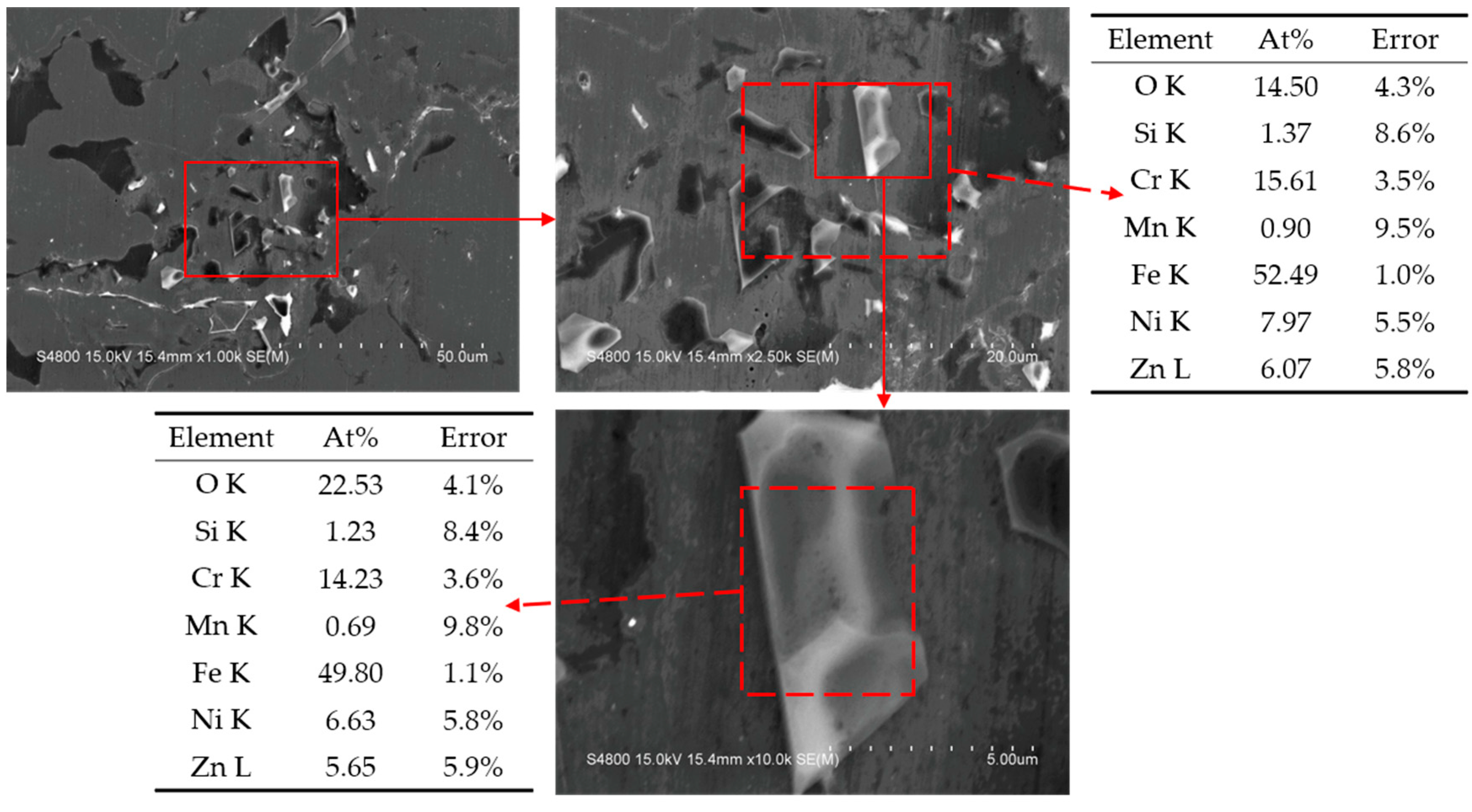

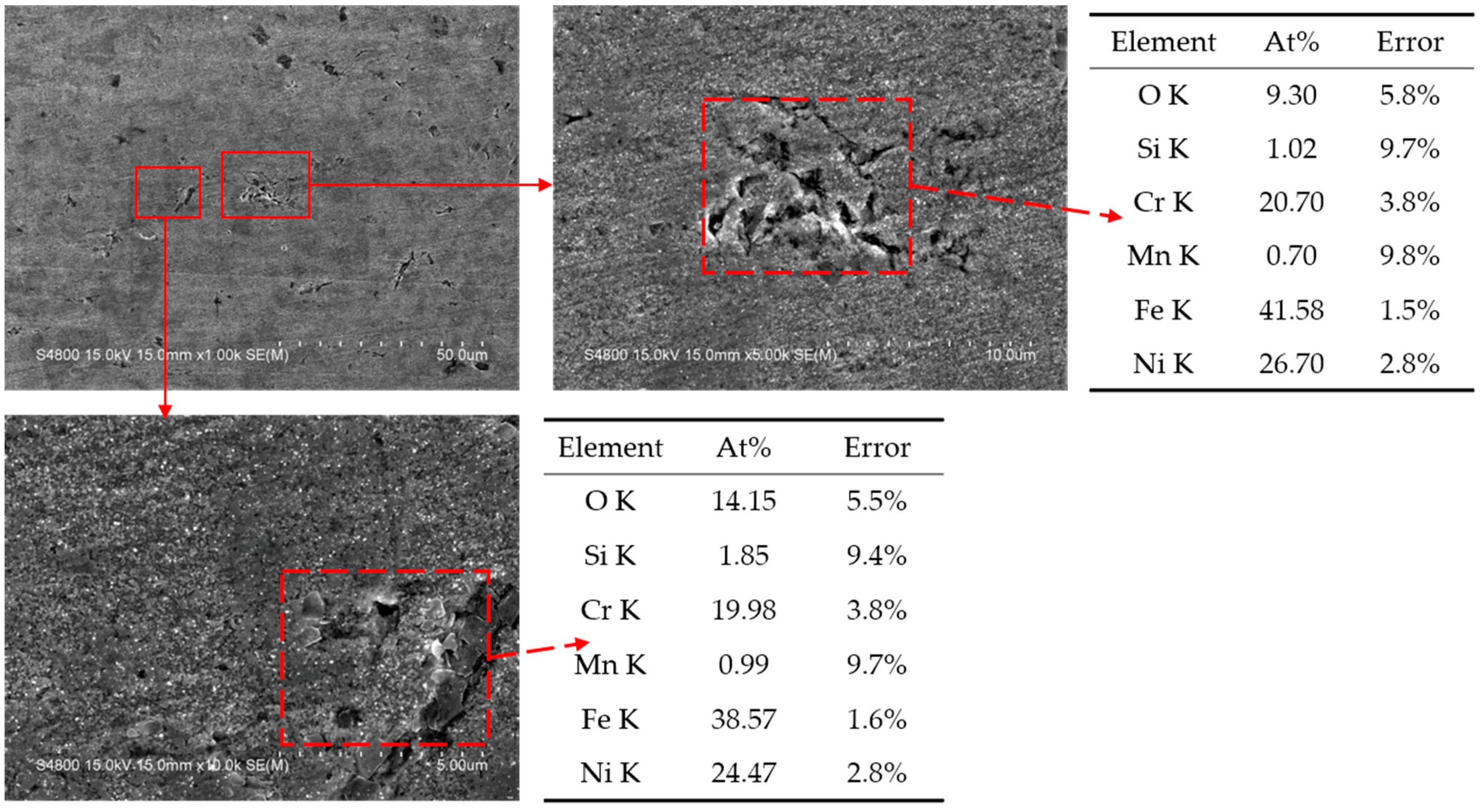
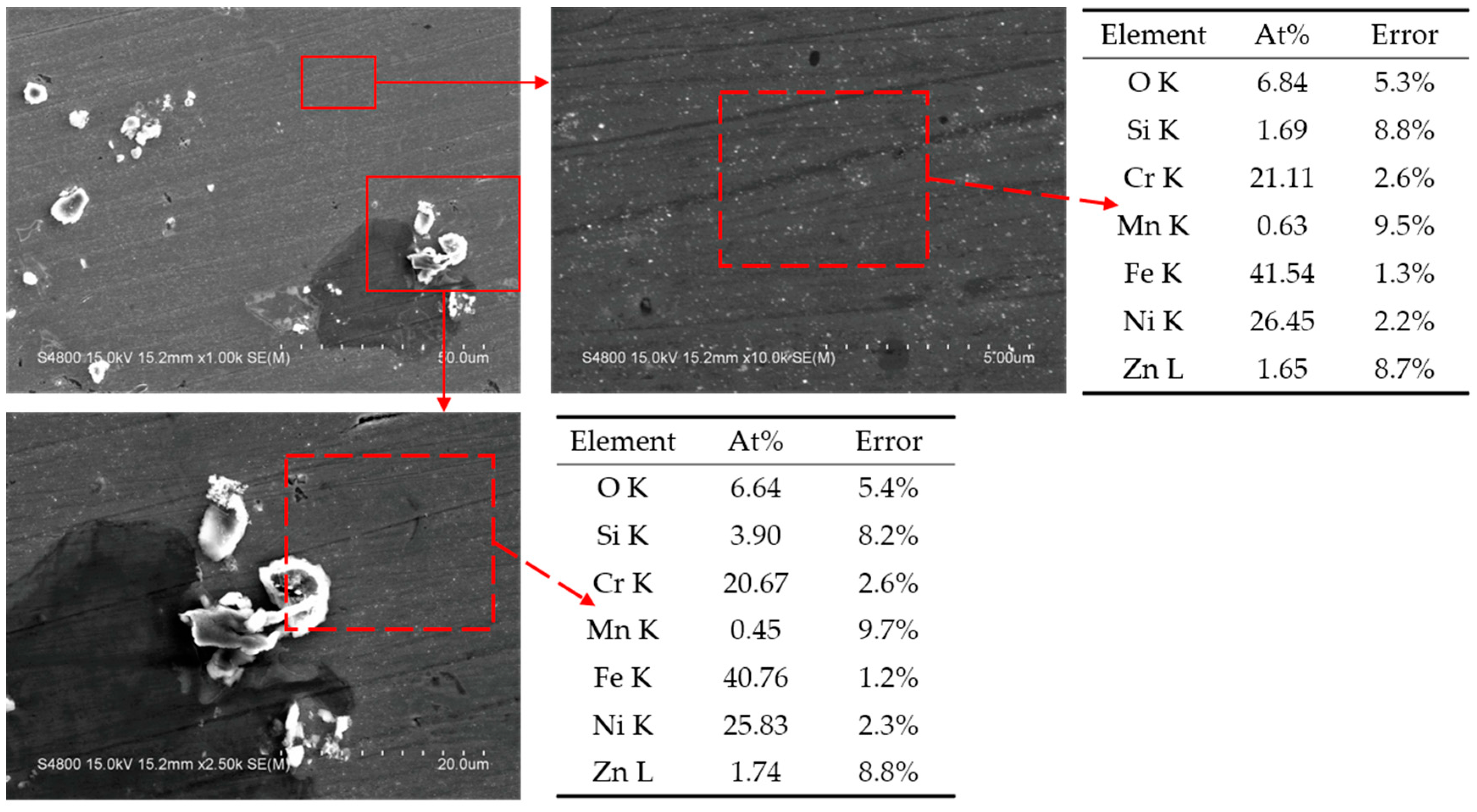
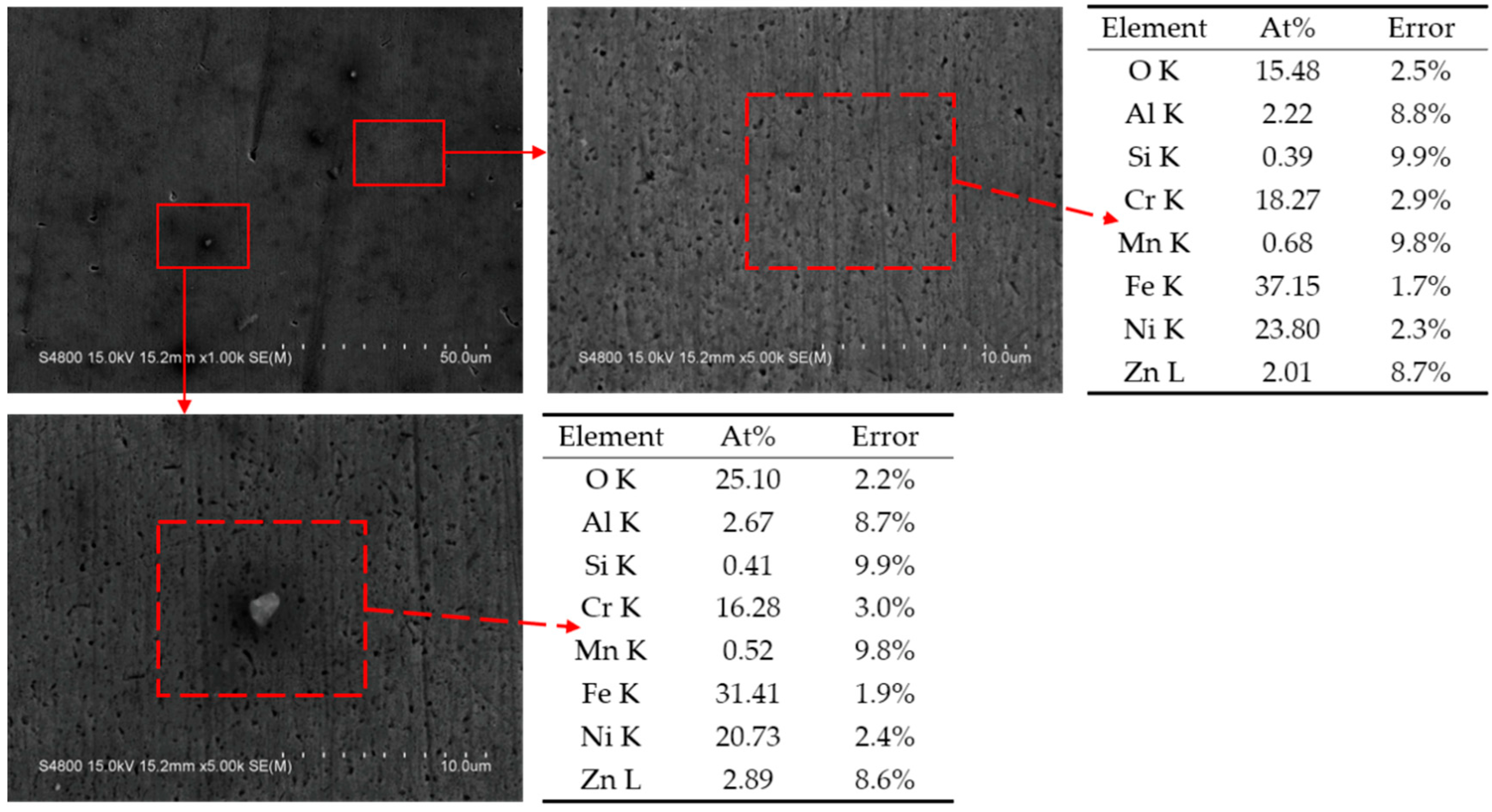

| Materials | C | Si | Mn | P | S | Cr | Ni | Mo | Cu | Fe |
|---|---|---|---|---|---|---|---|---|---|---|
| A508-3 | 0.22 | 0.228 | 1.39 | 0.012 | 0.003 | 0.122 | 0.068 | 0.54 | 0.117 | Bal. |
| 304L | 0.03 | 0.52 | 1.03 | 0.017 | 0.006 | 18.01 | 9.60 | - | - | Bal. |
| In800 | 0.04 | 0.85 | 1.50 | 0.030 | 0.015 | 21.20 | 32.50 | - | 0.3 | Bal. |
| Group | B (ppm) | Li (ppm) | Zn (mol/L) | Al (mol/L) |
|---|---|---|---|---|
| G(blank) | 250 | 1.1 | - | - |
| G(Zn) | 250 | 1.1 | 0.24 | - |
| G(Zn + Al) | 250 | 1.1 | 0.12 | 0.12 |
| Group | A508-3 | 304L | In800 | |||
|---|---|---|---|---|---|---|
| Icorr (A/cm2) | Ecorr (V) | Icorr (A/cm2) | Ecorr (V) | Icorr (A/cm2) | Ecorr (V) | |
| G(blank) | (2.27 ± 0.13) × 10−5 | −0.37 ± 0.06 | (1.23 ± 0.13) × 10−6 | −0.14 ± 0.06 | (5.74 ± 0.08) × 10−8 | −0.26 ± 0.04 |
| G(Zn) | (2.82 ± 0.09) × 10−6 | −0.59 ± 0.04 | (4.17 ± 0.18) × 10−7 | −0.42 ± 0.08 | (5.09 ± 0.12) × 10−8 | −0.27 ± 0.03 |
| G(Zn + Al) | (2.19 ± 0.12) × 10−6 | −0.55 ± 0.05 | (2.82 ± 0.08) × 10−7 | −0.17 ± 0.03 | (9.31 ± 0.10) × 10−8 | −0.22 ± 0.04 |
| Group | Rs (Ω/cm2) | Qout | Rout (Ω/cm2) | L (H/cm2) | Qin | Rin (Ω/cm2) | |||||
|---|---|---|---|---|---|---|---|---|---|---|---|
| Y(secn/cm2) | n | Y(secn/cm2) | n | ||||||||
| A508-3 | G(blank) | 4.11 | 2.36 × 10−4 | 0.553 | 5.72 × 100 | 42.5 | 5.89 × 10−6 | 7.67 × 10−4 | 0.936 | 911.2 | 1.62 × 104 |
| G(Zn) | 1.03 | 9.92 × 10−6 | 0.593 | 7.58 × 10−2 | 83.1 | 3.35 × 10−13 | 1.96 × 10−4 | 0.811 | 561.0 | 4.65 × 105 | |
| G(Zn + Al) | 5.02 | 1.43 × 10−7 | 0.971 | 9.84 × 10−2 | 25.7 | 4.81 × 10−10 | 1.29 × 10−4 | 0.729 | 459.3 | 2.36 × 105 | |
| 304L | G(blank) | 5.09 | 8.12 × 10−6 | 0.944 | 4.82 × 100 | 19.0 | - | 7.85 × 10−5 | 0.801 | 331.7 | 4.21 × 106 |
| G(Zn) | 7.46 | 8.37 × 10−9 | 0.989 | 7.10 × 10−3 | 43.7 | - | 3.30 × 10−5 | 0.890 | 83.0 | 5.29 × 107 | |
| G(Zn + Al) | 1.08 | 6.70 × 10−9 | 1.000 | 6.70 × 10−3 | 41.6 | 7.26 × 10−5 | 0.808 | 120.8 | 1.16 × 107 | ||
| In800 | G(blank) | 5.94 | 3.56 × 10−8 | 0.874 | 5.24 × 10−3 | 47.4 | - | 9.53 × 10−6 | 0.947 | 119.5 | 5.99 × 106 |
| G(Zn) | 4.76 | 3.17 × 10−5 | 0.862 | 1.29 × 10−1 | 114.0 | - | 1.06 × 10−3 | 0.759 | 1920.1 | 8.66 × 106 | |
| G(Zn + Al) | 8.71 | 5.76 × 10−9 | 1.000 | 5.76 × 10-3 | 42.1 | - | 5.27 × 10−5 | 0.806 | 219.3 | 7.17 × 106 | |
| Group | A508-3 | 304L | In800 | |||
|---|---|---|---|---|---|---|
| (cm−3) | (cm−3) | (cm−3) | ||||
| G(blank) | (7.71 ± 0.21) × 1020 | −0.72 ± 0.04 | (2.61 ± 0.09) × 1020 | −0.23 ± 0.02 | (1.64 ± 0.11) × 1020 | −0.25 ± 0.03 |
| G(Zn) | (4.50 ± 0.19) × 1019 | −0.51 ± 0.04 | (4.34 ± 0.39) × 1020 | −2.90 ± 0.12 | (1.75 ± 0.10) × 1020 | −1.34 ± 0.05 |
| G(Zn + Al) | (3.43 ± 0.12) × 1019 | −0.41 ± 0.02 | (1.41 ± 0.15) × 1020 | −0.65 ± 0.04 | (2.26 ± 0.13) × 1020 | −1.62 ± 0.07 |
| Group | A508-3 | 304L | In800 |
|---|---|---|---|
| G(blank) | 15.2 | 5.5 | 2.0 |
| G(Zn) | 9.3 | 1.4 | 32.0 |
| G(Zn + Al) | 7.6 | 2.0 | 3.6 |
© 2020 by the authors. Licensee MDPI, Basel, Switzerland. This article is an open access article distributed under the terms and conditions of the Creative Commons Attribution (CC BY) license (http://creativecommons.org/licenses/by/4.0/).
Share and Cite
Zhang, S.; Sun, C.; Di, J.; Tan, Y. Corrosion Behavior and Morphology of Passive Films Modified with Zinc–Aluminum Simultaneous Treatment on Different Metals. Metals 2020, 10, 986. https://doi.org/10.3390/met10080986
Zhang S, Sun C, Di J, Tan Y. Corrosion Behavior and Morphology of Passive Films Modified with Zinc–Aluminum Simultaneous Treatment on Different Metals. Metals. 2020; 10(8):986. https://doi.org/10.3390/met10080986
Chicago/Turabian StyleZhang, Shenghan, Chenhao Sun, Jie Di, and Yu Tan. 2020. "Corrosion Behavior and Morphology of Passive Films Modified with Zinc–Aluminum Simultaneous Treatment on Different Metals" Metals 10, no. 8: 986. https://doi.org/10.3390/met10080986
APA StyleZhang, S., Sun, C., Di, J., & Tan, Y. (2020). Corrosion Behavior and Morphology of Passive Films Modified with Zinc–Aluminum Simultaneous Treatment on Different Metals. Metals, 10(8), 986. https://doi.org/10.3390/met10080986






